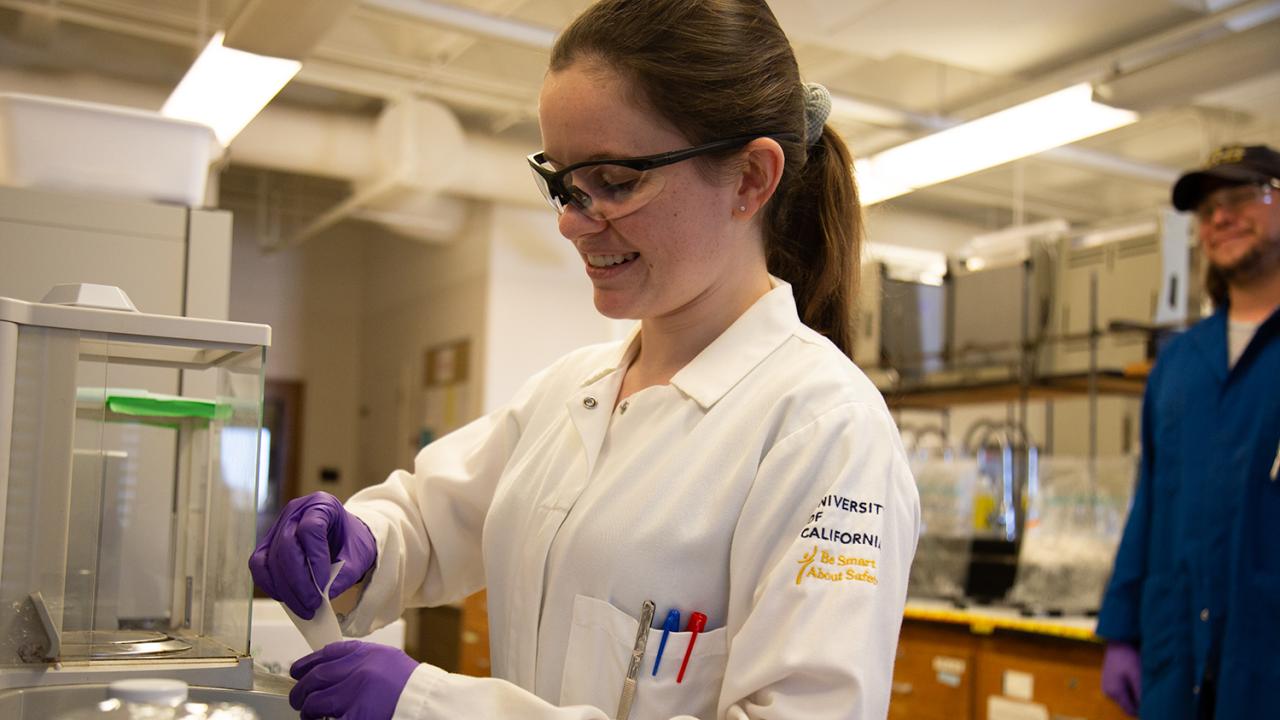
Climbing the Ladder of DNA with Francesca Miller Undergraduate Research Award Winner Madeline Bright
Quick Summary
- Biological sciences student Madeline Bright recently won the Francesca Miller Undergraduate Research Award
- In Professor of Chemistry Sheila David's lab, Bright studies how reactive oxygen species modify and damage our DNA
- Damage to the base molecules of DNA can lead to disease-causing mutations
Our DNA is built of base pairs, a spiral ladder of adenines, cytosines, guanines and thymines. In this molecular dance, adenine pairs with thymine and cytosine pairs with guanine. Their precise choreography ensures smooth and healthy cell functionality.
But interlopers can disrupt this flow. Reactive oxygen species, a natural result of our aerobic world, can modify or damage our DNA, which can lead to disease-causing mutations.
Undergraduate researcher Madeline Bright, a junior majoring in biological sciences, is trying to figure out just how this process works and if there are ways to halt it. Working in the lab of Professor Sheila David, Department of Chemistry, Bright is at the forefront of DNA repair research, specifically looking at how oxidative damage affects guanine.
Bright joined the David Lab during the second quarter of her freshman year. Since then, she’s explored her fascination with biochemistry, performing research in an interdisciplinary fashion fit for the “century of biology.” Her research on DNA repair enzymes resulted in her winning the Francesca Miller Undergraduate Research Award, an award for students performing research in chemical biology and organic chemistry.
“Maddy definitely lives up to her name,” said David. “She is incredibly ‘bright.’ I love the way her face lights up and her eyes sparkle when she talks about science and her research. It is so fun to have students like her in the laboratory!”


From the clinic to the research lab: the best of both worlds
When she arrived at UC Davis, Bright was certain she wanted to pursue medicine as a field of study. She’d spent some time in high school shadowing a pediatric pulmonologist at Duke University. The experience inspired an aspiration to become a pediatric oncologist. But a chemistry teaching assistant and graduate student named Robert Van Ostrand shifted Bright’s mindset toward research.
That’s “where you’re at the forefront of helping people in medicine,” said Bright. “You’re developing therapies and you’re understanding the human body and how it works and how to help it.”
“To really make a difference is to combine the research and the clinical elements,” she added.
"It was clear right away that Maddy has the inquisitive mind of a researcher,” said Van Ostrand. “Her attention to detail in student lab was top notch from the time I first met her. She made a very strong positive impression from her performance in class and in lab in her first quarter of chemistry with me.”
Intrigued by Van Ostrand’s research with the David Lab, Bright asked if there were any open undergraduate research positions. Unfortunately, there weren’t, but Van Ostrand offered to help Bright identify other labs of interest.
“I thought that someone with her ability, drive, and interest will thrive as a researcher, and that it benefits us all to support talented people like Maddy,” said Van Ostrand.
By the time Bright drafted a letter, something fortuitous had happened. An undergraduate research position had opened in the David Lab. Van Ostrand was looking for a new undergraduate to supervise.

Finding the cause of cancer mutations
Bright took quickly to the David Lab. She found the environment collaborative and uplifting, hallmarks that initially attracted her to UC Davis in the first place.
“It feels much more like everyone’s more of a family rather than looking out for themselves,” said Bright. “People always seem to work together.”
With Van Ostrand, Bright started studying the DNA repair enzyme MutY, which combats oxidative damage to guanine.
Oxidative damage turns guanine into 8-oxoguanine (8-OG), a DNA lesion that requires repair and looks like thymine. If left damaged, that 8-OG will be mispaired with adenine.
“It’s a complete mispair within the DNA, and a build-up of which can lead to carcinogenesis, so that’s why we’re interested in it,” said Bright.
“What we are specifically looking at,” she added, “is the recognition mechanism for MutY, so what flags as the mispairings there? What does MutY look for to prevent the damage from turning into mutation?”
Bright synthesized a previously unreported oligonucleotide substrate, which helps her and her colleagues better understand and describe the target recognition system of MutY. She won the Francesca Miller Undergraduate Research Award for this work.
“This research can later be used to develop different drugs and cancer therapies possibly,” she said.

The lab reinforces the classroom
When asked what advice she’d give to other undergraduates, Bright stressed that to truly know science, you have to see it outside of class. Concepts neatly packaged in the lecture hall can get messy in the lab. Undergraduate research experiences help students apply classroom-gained knowledge to real-world problems.
She also recommended students utilize College of Biological Sciences resources, like the advising services provided by the Biology Academic Success Center. Bright found those resources especially helpful for classes like organic chemistry.
“There were content reviews that were twice a week and then workshops that were twice a week, so I went to all of those and then I did outside studying,” she said.
When Bright learns about a new concept, she often finds herself falling down a rabbit hole of inquiry, reviewing video tutorials, Wikipedia pages and National Center for Biotechnology Information readings, among other materials. This inquisitive nature keeps her continuously engaged.
“I like understanding things as much as possible,” said Bright. “It’s not so much that I want to be the smartest person in the room; it’s that I want to be able to have educated conversations with people I’m working with.”
It’s all rooted in a general fascination with biochemistry.
“We’re really just a walking system of individual organisms,” she said. “It’s interesting how it all works together.”

